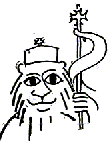



As an introduction, it is necessary to give briefing about the purpose and aim of producing the comic story before we talk about itís methods and work.
The comic story is meant to reflect the life and history of the displaced people, who are now living in and around Addis Ababa, in a very small and shabby plastic kind of shelter, dependent on relief and partly on very small help they get form the government.
These displaced people became displaced because of the political change that had taken place 6 years ago and they are mostly from the Northern part of the country.
Almost all of them had been working in the former government in the military field, civil work and also as merchants. So one can say that they were having a good standard life. But after the war they lost almost every thing their house, material possession, family member, social status even their self confidence, dignity, hope and they are now left with no future at all. These and other kinds of problems aggravate the situation of the displaced and brought a permanent problem, like being traumatised and other mental and physical sickness apart form the material and social need that they are now facing.
In order to take these displaced out of their misery, pain and hopelessness and put them in a position where they can help themselves, our project, called Collective Trauma, starts its own research by implementing its own project under the A.A.U. Though the project works in a way that is different from other NGOís, it also has an interest in working together with some of the NGOís here in Addis.
The research was undertaken by interviewing different people from the displaced in different camps, about their past life and history, good, bad every thing that they can provide us with. And we also did some interviews from other story tellers about the up and downs of the displaced.
The 1st step towards the process of producing the comic story has began based on the information gathered in this way. Though, it was hard and tiresome in collecting the informationís, we managed to do our first episode with patient and understanding heart.
Generally, we can say that the dependency of our writing and drawing is on what we saw, heard and what exactly is happening. And these kinds of work are better done by local professional, hence they know the culture and tradition.
The comic story that we are now doing has become one of the important means to solve the problem of traumatised people. This project is the out come of many researches done in order to help the displaced and other dependent needy people to be an independent citizens.
The process to which the comic story has undertaken were as follows:-
1st we spent about 2 & 1/2 months on studying the various culturally oriented graphics, especially those which have some connection to the Orthodox church and we took them as an insight for our drawing.
For example, eye, hair and body structures are some of the expressions
that we took from the cultural drawing style of the Orthodox.

Our drawing style is so cultural because of the following reasons:-
For the characters and the personalities.
The story is about 5 individuals who lives in the camp and tries to
get their living by working as a daily labourers. These people were originally
real persons who wants to leave the camp and live by themselves. But, as
we go further we face problems to follow these people all the way through
and develop it in to a story. So we made a discussion and decided to change
the story in to fiction but, with our culture and tradition based
manner. Because, we have to have some direction of plan on how to finish
the story and also on where we are going. Thus, making the story fiction
but still with realistic nature will give a liberty for good creative
and artistic work, we believe.
Second, we have included some of the wild animals like Lion, Ape, Snake and Dove in the story. And the following will be the work of these animals:
The Lion:
The lionsí role in the story is to act in a very decisive, courageous
and brave manner wanting the displaced to move out of the camp immediately
and start living by their own.
The Ape:
This ape has a wise and soft personality and, though she agreed with
the lionís idea of getting out of the camp, she also suggests to stay a
bit longer until further studies made so as to help the displaced find
a means to be on their own.
The Snake:
The snake has a very wicked and crude personality and doesnít want
the displaced leave the camp and be on their own.
The Dove:
The dove has been given a personality of peace and sincerity.
Third, we have taken some of the domestic animals which are cat, dog,
hen, sheep, and rat. They are used in the story to express some of the
bad thoughts and ideas of the human being which are not pleasant to be
heard if they are spoken by human, especially in the Ethiopian context.
When we come to the first episode, it is not as such very much impressive because, we just take it as an introduction, starting from the selection of tittle, figures and language.
The second episode, we can say is better than the first, in a way that is more touchy and the composition, the tittle and the language itself is more sound. The time which had been taken was also longer than the first one.
These are the things that we would like to say for the first and second
episode. We hope, the third and the following will come with more potential
and better composition.
Edited & Translated by
Sefanit Gebeyehu